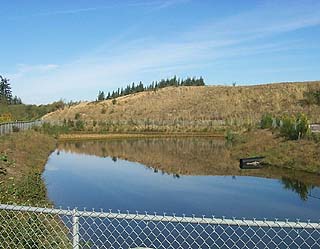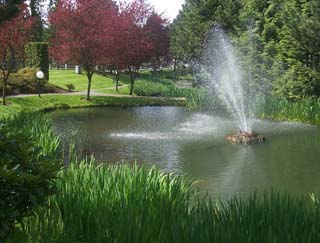
Surveys
DJC.COM
July 25, 2002
Detention ponds – all it takes is a little magic
Triad Associates

Loomis |
Stormwater ponds are usually developed at the low points of relatively flat or moderately sloped sites, often adjacent to project entries. With such visibility, care should be taken in designing ponds.
Designing a pond to be functionally and visually integrated into the larger development turns it into an asset rather than an eyesore. Here are some ways to find the magic.
Aesthetic vision
Work the engineering design into your desired look for the end product. Avoid constructing a rectangular pond with a chain link fence. Create a place where people want to congregate rather than avoid. Consider ways to increase the overall project value by creating a curvilinear, irregularly shaped pond with rockeries, gentle slopes, landscaping, and waterfalls or fountains. Be sure to include appropriate landscaping to help screen the pond from adjacent homeowners, provide a habitat for wildlife, or blend a pond into the surrounding development.
Prepare for tradeoffs

Photos courtesy of Triad Associates Aesthetics aren’t emphasized on many traditional storage ponds. |
A more visually appealing pond will require more land than the most efficient engineering design. However, the loss of a few lots can be more than offset by the increased project value of integrated, accessible, and usable recreational or open space.
One way to reduce the space required for a pond is to increase its depth. Building berms, dams or other vertical walls can reduce its footprint. This may involve earth movement, so the cost versus benefit should be analyzed. Slope stability must be assured on the downhill side of a berm or dam. Also, special construction may be needed to prevent groundwater seepage, saturation and erosion.
Recreation and open space
Placing recreational facilities in the bottom of mostly dry detention ponds can better integrate the facility into the community. Consider oversizing ponds in golf course developments or when ponds are constructed as multipurpose recreational or open space amenities. Adding more dead storage capacity allows the captured water to be reused for irrigation.
Using existing wetlands

A well-designed pond integrates into its surroundings.
|
In some jurisdictions, existing wetlands can be enhanced to include detention. Integrating ponds with adjacent wetlands creates a more seamless transition between the built portions of the project and sensitive areas. Use of appropriate plantings is important for aesthetics, as well as water cleansing value and wildlife habitat enhancement.
The regional approach
Have the foresight to plan stormwater detention on a regional basis in developing areas. A regional approach to stormwater detention can be more cost effective for design, construction and maintenance. Ponds can be designed for multiple purposes and integrated in a neighborhood design for open space and recreation. Builders can contribute via a latecomer’s fee for sharing costs.
Here are some added technical considerations to keep in mind:
Soil conditions
Analyze soil and groundwater conditions before deciding to simply locate ponds at the low point of sites. A thorough analysis will expose potential problems for meeting detention requirements.
For example, bedrock is difficult to excavate. High ground water tables reduce the space available for storage. Gravelly or cobbled soils may be excessively permeable so that storage and filtration capabilities are compromised. These conditions can be mitigated, but at an added cost.
Runoff rates
Carefully analyze existing runoff rates to achieve the maximum allowable on-site release rate to reduce the volumes required for detention ponds. Many times, peripheral areas of sites do not drain into the primary basin.
Some jurisdictions allow these areas (called “bypass”) to be subtracted from the release rate if the flow is addressed in other ways. Leaving such areas as open space or active recreation space means they will be considered at pre-development drainage rates, thereby reducing detention volumes and costs.
Maintenance
Design a pond with long-term maintenance in mind. Consider this when designing access and when selecting and locating various trees, shrubs and ground cover. Many older ponds have failed over time due to sedimentation, which reduces the pond’s storage volume and/or clogs flow control systems. New geotechnical engineering approaches are now available to rejuvenate and extend the life of existing ponds.
In September 2001, the state Department of Ecology adopted an increased standard for stormwater detention similar to the King County Runoff Time Series. This standard is much higher than those used by many jurisdictions other than King County. Preliminary designs of ponds often are based just on local standards. If you anticipate needing any kind of state permit, such as a hydraulic project approval, your initial designs should meet the more restrictive state requirement.
Clay Loomis, P.E., is vice president and director of the engineering department at Kirkland-based land development consultant Triad Associates.
Other Stories:
- Water storage goes underground
- Getting back to basics with LEED
- Seattle LEEDs the nation in sustainable building
- New stormwater rules looming for contractors
- An incubator for cutting-edge power projects
- Linking up with the environment
- Designers find new life for old cardboard tubes
- EPA turns up the heat with temperature rules
- AGC teams with WSDOT for environment’s sake
- A wholistic look at engineering
- Toxic black mold — the next asbestos?
- Mold: Getting a grip on the fuzzy stuff
- A trail of mining waste turns into a trail of recreation
- No more fuming at chemistry class
- A battery of energy information
- New brownfields law comes with big changes
- ‘Green infrastructure’ puts Seattle on the map
- Ground zero for groundwater
- A pearl of a project on Oyster Creek
- BetterBricks program stacks up energy savings
- Shopping ‘green’
- Home Depot builds atop an old Oregon landfill
- Making clean water the green way
- Salmon in the city: Seattle restores fish habitat
- A funny thing happened on the way to the dump
- Reducing energy costs, post crisis
- Managing stormwater in Pierce County
- Does best available science work for all buffers?
Copyright ©2009 Seattle Daily Journal and DJC.COM.
Comments? Questions? Contact us.